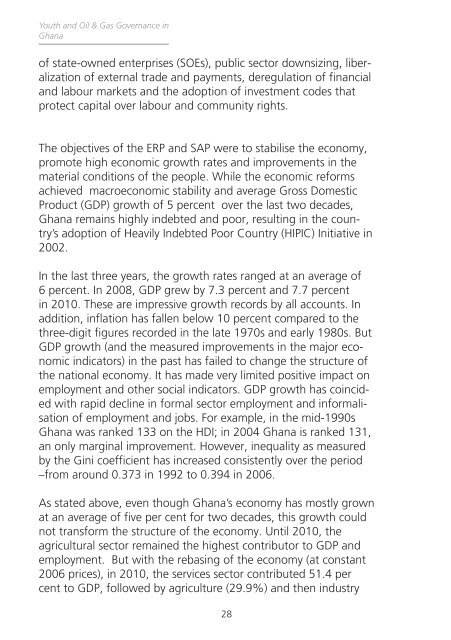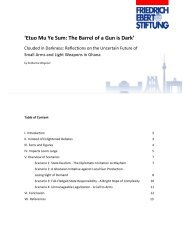Youth and Oil & Gas Governance in Ghana - Friedrich-Ebert-Stiftung ...
Youth and Oil & Gas Governance in Ghana - Friedrich-Ebert-Stiftung ...
Youth and Oil & Gas Governance in Ghana - Friedrich-Ebert-Stiftung ...
Create successful ePaper yourself
Turn your PDF publications into a flip-book with our unique Google optimized e-Paper software.
<strong>Youth</strong> <strong>and</strong> <strong>Oil</strong> & <strong>Gas</strong> <strong>Governance</strong> <strong>in</strong><strong>Ghana</strong>of state-owned enterprises (SOEs), public sector downsiz<strong>in</strong>g, liberalizationof external trade <strong>and</strong> payments, deregulation of f<strong>in</strong>ancial<strong>and</strong> labour markets <strong>and</strong> the adoption of <strong>in</strong>vestment codes thatprotect capital over labour <strong>and</strong> community rights.The objectives of the ERP <strong>and</strong> SAP were to stabilise the economy,promote high economic growth rates <strong>and</strong> improvements <strong>in</strong> thematerial conditions of the people. While the economic reformsachieved macroeconomic stability <strong>and</strong> average Gross DomesticProduct (GDP) growth of 5 percent over the last two decades,<strong>Ghana</strong> rema<strong>in</strong>s highly <strong>in</strong>debted <strong>and</strong> poor, result<strong>in</strong>g <strong>in</strong> the country’sadoption of Heavily Indebted Poor Country (HIPIC) Initiative <strong>in</strong>2002.In the last three years, the growth rates ranged at an average of6 percent. In 2008, GDP grew by 7.3 percent <strong>and</strong> 7.7 percent<strong>in</strong> 2010. These are impressive growth records by all accounts. Inaddition, <strong>in</strong>flation has fallen below 10 percent compared to thethree-digit figures recorded <strong>in</strong> the late 1970s <strong>and</strong> early 1980s. ButGDP growth (<strong>and</strong> the measured improvements <strong>in</strong> the major economic<strong>in</strong>dicators) <strong>in</strong> the past has failed to change the structure ofthe national economy. It has made very limited positive impact onemployment <strong>and</strong> other social <strong>in</strong>dicators. GDP growth has co<strong>in</strong>cidedwith rapid decl<strong>in</strong>e <strong>in</strong> formal sector employment <strong>and</strong> <strong>in</strong>formalisationof employment <strong>and</strong> jobs. For example, <strong>in</strong> the mid-1990s<strong>Ghana</strong> was ranked 133 on the HDI; <strong>in</strong> 2004 <strong>Ghana</strong> is ranked 131,an only marg<strong>in</strong>al improvement. However, <strong>in</strong>equality as measuredby the G<strong>in</strong>i coefficient has <strong>in</strong>creased consistently over the period–from around 0.373 <strong>in</strong> 1992 to 0.394 <strong>in</strong> 2006.As stated above, even though <strong>Ghana</strong>’s economy has mostly grownat an average of five per cent for two decades, this growth couldnot transform the structure of the economy. Until 2010, theagricultural sector rema<strong>in</strong>ed the highest contributor to GDP <strong>and</strong>employment. But with the rebas<strong>in</strong>g of the economy (at constant2006 prices), <strong>in</strong> 2010, the services sector contributed 51.4 percent to GDP, followed by agriculture (29.9%) <strong>and</strong> then <strong>in</strong>dustry28









